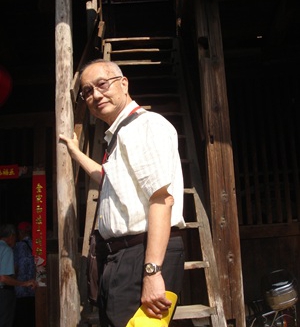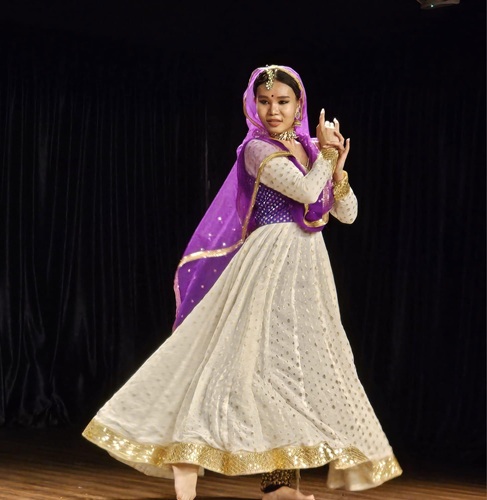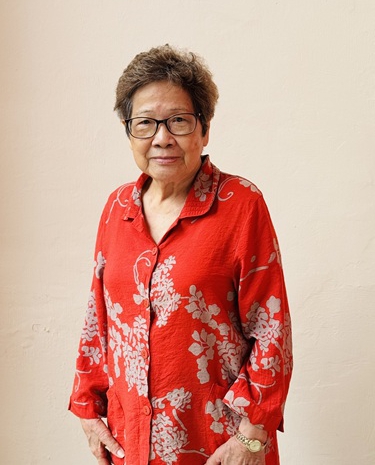令人缅怀的华中校长
——薛承明心目中的父亲薛永黍
文·莫美颜
图·受访者提供

薛永黍的长子薛承明:父亲是一位值得敬仰和怀念的长辈 (莫美颜摄)
时间如梭,创办于1919年,现已开办六年直通车综合课程的自主学校──华侨中学即将在明年迈入100年。华中作育无数英才,是本地一所校誉斐然的学府。华中今日的成就有许多人的功劳与付出,除创办人陈嘉庚,值得人们缅怀与颂赞的华中先贤就包括了华中第十届校长薛永黍(1889-1951)。从其长子薛承明(78岁)所收集的书报资料中,让我们再次看到薛永黍高大可敬的形象。
海外的蔡元培
薛永黍祖籍福建金门,他早年留学美国,考获美国密西根大学教育学士及历史学硕士。1937年,经同乡郑古悦推荐,受聘为华中校长。任内他废除了旧式管制及惩罚方式,对学生采取开明与开放教育方针,并先后成立了学生自治会和学生宿舍及膳食会,由学生自行管理日常生活,鼓励学生办壁报,培养学生的组织能力与写作能力。教师聘用方面,他采取惟贤任用的策略,只要他们教学有方,学有所长,不问政治主张、思想倾向都“兼容并包”,但规定不许在课堂上谈论政治。校内一时海纳百川,开“学术”与“自由”之风尚,故薛永黍有“海外蔡元培”的称誉。
二战结束初期,华中董事长李光前尚未回返新加坡,薛永黍便继续掌校挑起复办华中的重任。
治理华中期间,薛永黍对社会活动也十分热心。中国全面抗日爆发后,他热烈响应陈嘉庚的号召领导学生宣传抗日;新加坡沦陷前夕,他到处奔波为教职员争取遣散费安顿生活。
1938年薛永黍与高佩珊、张明茨等人,倡议组织教师公会“六六社”,在协助华文教师解决生活问题,帮助学生到中国升学等方面做了不少工作。
1948年薛永黍因批准华中与南洋女中的学生自治会5月4日在华中大礼堂举办五四纪念会而引起殖民地政府不满,迫使董事会要求薛永黍制止学生开纪念会。 薛永黍宁可辞职也不愿收回成命,董事会迫于无奈只好接受他的辞呈。
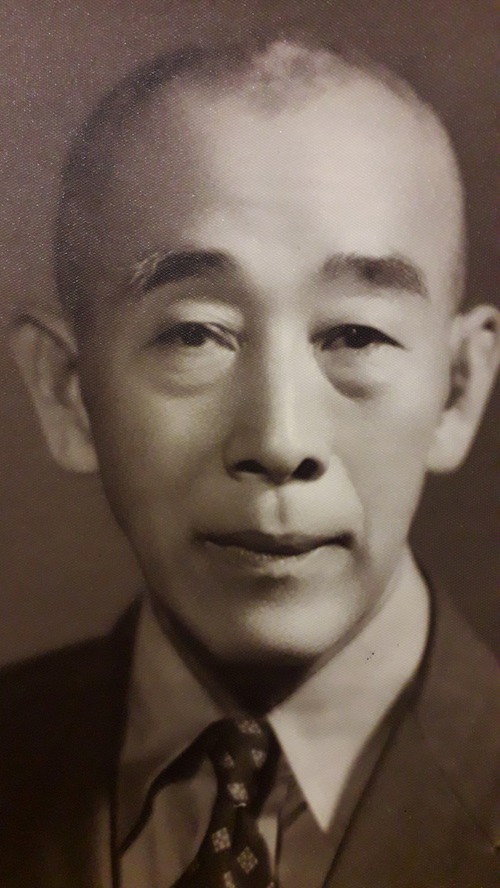
薛永黍是华中第十届校长
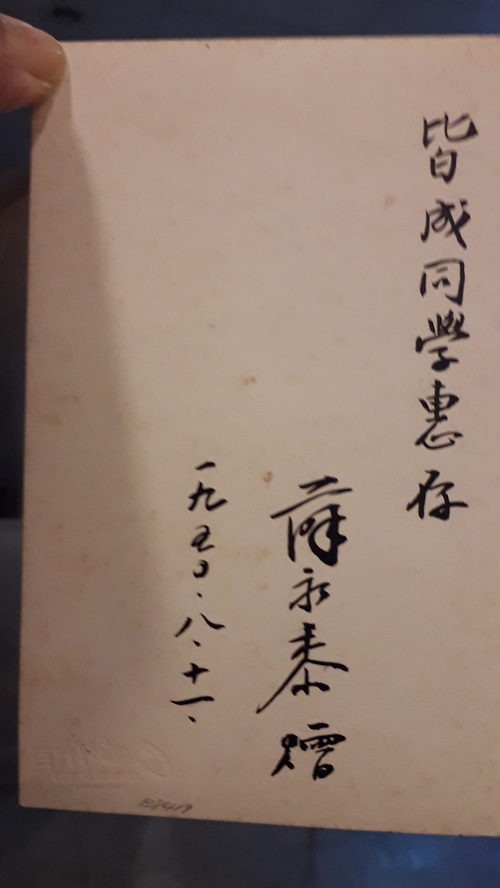
离开华中后薛永黍还送学生个人照

薛永黍经常题词勉励学生
师生永远怀念的校长
从1937年到1948年,薛永黍在华中服务了11年。他对全校师生关爱有加,怀念和颂扬他的师生不少。
薛承明所收集的资料,包括一份1992年华中颐年俱乐部第三届职员就职典礼上,沈文炳以监誓员身份所发表的谈话记录。沈文炳于1946到1948年在华中任教时与薛永黍共事。
会上他说,战后华中复办的那三年,是华中校史上最光辉和最灿烂的时代。给他留下深刻印象的事项,除上述几项,薛永黍还组织童军团,使华中成为第一所有童军团组织的华校;他也重视英文教学,使华中双语人才辈出;重视体育活动,使华中在运动竞技场上扬威。
沈文炳认为,师生之所以怀念薛永黍,主要是大家都认为薛永黍是一位德高望重,高风亮节的领导者,而且他视同事如朋友,视学生如子侄。
薛承明珍藏着一帧父亲于1950年送给他的学生皆成的个人照。这名现居印度尼西亚的学生,如今已白发苍苍。几年前他特地从印尼把照片交给了薛承明。1950年薛永黍已不在华中任教,仍与学生保持联系,可见他与学生相处融洽。
叶帆风在1996年著述的《风雨萍踪十五载》中也说,薛永黍非常注重人格感化教育,不仅大力灌输学生爱国思想、传播新文化,也重视学生课业与课外活动的调剂,并称赞薛永黍因以仁慈和蔼的态度及诚挚的爱心对待师生,故深得广大师生的信任和爱戴。
叶帆风是新民学校创办人,生前与薛永黍关系密切。薛永黍是他在厦大附中高中部念书时的导师,两人曾在教师公会共事,也是中国民主同盟的盟友,在“昆兴事件”中更是同处一牢房的难友。
昆兴事件的牺牲者
薛永黍若仍健在已经129岁了,他离世时时年62。薛家是1951年11月10日从新加坡中央医院那里接获薛永黍病逝的噩耗的,至今也已67载。
1950年6月25日清晨,一批警探从华中一间木板屋把在昆兴公司任职的薛永黍带走,至此薛永黍就再也没踏进家门一步。薛永黍离开华中后便加入民主同盟会友创办的树胶出入口商行昆兴公司,担任财政兼文书。
1950年朝鲜战争爆发后,一些商人为了支援中国抗美援朝,不顾美国对中国实施禁运令,甘冒被逮捕和被驱逐出境的风险,把列为禁运品的橡胶运到中国。美国的亲密伙伴英国严格监视偷运活动,1951年4月12日,英国空军在海南岛附近水域发现运载3700号橡胶自新加坡启程前往中国的货轮“南西摩勒”号,该轮船上的橡胶是昆兴公司托运的货物。
这起“昆兴事件”共逮捕了15人,其中三人问话后获释,12人继续被扣押,薛永黍是当中一个。薛永黍本来身体健壮,只是有胃病,扣留期间由于生活条件很差,以致他的健康每况愈下。他曾写信给政治部主任要求让他到中央医院或延请医生到拘留所为他治病,却未获回音。直到他病情恶化时,棋樟山难友联合签名,声称若不让 薛永黍就医将全体绝食,殖民地政府当局才送他到中央医院求医。结果薛永黍入院几天后就去世了。
薛永黍逝世的消息轰动新马华人社会,许多人指责殖民地政府草菅人命。消息传到北京,中国政府通过中央人民广播电台向英殖民地政府提出抗议,指薛永黍曾受虐待。11日出殡,数百人送他最后一程,棋樟山的政治犯在狱中举行追悼会,1000多名北京归国华侨在中山公园举行追悼大会。
薛永黍离世后薛家获得多方协助
薛承明说:“父亲有两段婚姻,他的第一任太太出身不错也曾留学美国,因没生育,在父母安排下娶杨莲叶为妻。”杨莲叶现年100岁,她与薛永黍育有两男三女,薛承明为长子。
他说,父亲在华中任职时一家人寄宿在学校的虎豹楼内,离职后则住进学校老工头特地为他们盖的一间亚答屋里,地点就在现华中校友会游泳池旁。
薛永黍是家庭的唯一经济支柱,他去世时薛承明还不满12岁,但妻小的生活如常。薛承明说:“这主要是他们一家得到李光前、庄丕唐和李吉成等人的协助,并获得中国民主同盟的2000元抚恤金,念中小学时有关学校又不收他和弟妹的学杂费,妈妈则替人缝制旗袍,日子还算过得去。”
帮助过薛家的人,最令薛承明感激的是庄丕唐。庄丕唐是一名非常热心华文教育的商人,上世纪20年代南来,适逢本地华校反抗英殖民地教育条例,他随即成为华教学务维持处要员之一。
薛承明说:“父亲和庄丕唐是莫逆之交,父亲去世后他和太太视我如己出,特别关心我的学业和生活。”薛承明高中毕业后当过一阵子小学教员,原想到南洋美专修读美术课程,后到南大念地理系。原来画家陈文希是薛承明中三的美术老师,他常带学生出外写生,薛承明在他的潜移默化中爱上了美术。是庄丕唐坚持要薛承明去念大学,他才改变初衷,庄丕唐对薛承明的影响可见一斑。
念大学时,薛承明除获得政府助学金外也教补习。完成学业后被分配到政府机构工作。他后来到新加坡大学进修;离开公职后曾在国泰机构担任营运经理;也经营餐馆,一度想进军中国但不成功。2006年结束餐馆生意后便进入半退休状态。
薛承明自白:“我没想涉足政治,也没跟父亲一样从事教育工作,一心只想为生活努力工作,过着风平浪静的日子。我就这样随波逐流,生活平庸无大志。”
薛承明的弟妹也各有志向和出路。他的弟弟自新加坡大学毕业后负笈新西兰并考获硕士学位,他的大妹和二妹高中毕业后执教鞭,最小的妹妹南大毕业后再到外国攻读高级学位。薛永黍给后代留下丰厚的精神遗产,薛承明一直以父亲为荣耀。他说:“父亲留给家人一笔丰厚的精神遗产,值得珍惜。”
薛承明育有一男一女,孩子小的时候他会通过各种方式让他们多了解他们祖父的生平事迹。他也经常带他们拜访父亲的同辈,让孩子从这些长辈的忆述中多认识他们的祖父。1995年他还带儿子出席《新华历史人物列传》推介会,薛永黍是书中所列的历史人物之一。
尽管父亲当年的一些政治观点现在看来也许有点争议性,但薛承明认为,他的为人处世有许多值得家人和后代学习的地方。
印象中的父亲
薛永黍祖父曾是清朝官吏,他出生的金门珠山乡富裕者多,又重视教育。薛永黍是第一个留学海外的金门人。他在家乡念完书后到福州英华学院升学,毕业后到美国深造。
在薛承明印象中,父亲生活洋化。他爱吃面包和乳酪,爱拉手风琴和吹喇叭,爱听西洋音乐。他生前家里就收藏不少唱片,第一任太太也是爱好音乐的美国留学生。
薛承明记得:“父亲每天都会带一份《海峡时报》回家。我就利用这份报纸学习英文,碰到不明白的地方就问父亲,父亲总会耐心地为我解答。父亲也记得别人对他的好,比如买瑞士卷回家给家人当点心时,学校工头的子女也一定有份。当年瑞士卷可是下午茶的好料。其实父亲很节俭,午餐可以是一杯咖啡加一片烤面包。”
虽然工作忙碌,薛永黍会设法腾出时间陪陪孩子,比如带他们到郊外游泳;到美世界吃豆馔;到戏院看戏。薛承明最记得的是父亲带他去看《百万雄狮下江南》,那是一部有关中国人民解放军解放中国的纪录片。
除了工作,薛永黍也经常受邀在社团主办的婚礼上当证婚人,由他证婚的就包括企业家黄祖耀。
薛承明说:“父亲就是这样一位值得敬仰和怀念的长辈。”
(作者为本刊特约记者)
The unforgettable principal of Hwa Chong
Recollections of See Seng Min of his father Sy Eng Su
Time flies. Established in 1919 and now already 6 years as an express integrated programme school, Hwa Chong Institution will be celebrating its 100th anniversary next year. Hwa Chong has produced innumerable elites, and is now an educational institution of solid repute.Established by the diligence and efforts of many, especially the founder Tan Kah Kee, there were many commendable contributors, one of which is the 10th principal Mr. Sy Eng Su, aka Sy Ong Sway (1889 – 1951). It was from his eldest son, See Seng Min (78 year), who shared his collection of newspaper cuttings and memorabilia, we can now reacquaint ourselves with his admirable work.
Sy Eng Su, from Fujian Province, JinMen County, had his early education in the United states, University of Michigan graduating with a Bachelors degree in Education and a Masters Degree in History. In 1937 with the recommendation of a fellow countyman Tay Koh Yat, he was appointed the Principal of Hwa Chong. On assuming the post, he abolished the old style of management, especially corporal punishment, and established a liberal and open wall newspaper. Also permitted the students to self-manage their hostels, food selection, free choice of their daily livelihood and encouraging open notice boards for their views. Teachers were recruited for their dedication and diligence regardless of political leaning. However, teachers must adhere strictly to the rule that no politics are allowed in the classrooms. There were claims that Sy was reputed to be the “overseas Cai YuanPei”.
After the end of the Second World War, the Chairman of Hwa Chong Lee Kong Chian re-appointed Sy as Principal to rebuild the school.Sy was extremely public-spirited in nature, rallying the students to support Tan Kah Kee’s call to fight the Japanese invasion of China. Just before the fall of Singapore, he also campaigned openly for teachers’ severance pay to adequately meet living costs. In 1938, together with Gao PeiShan and Zhang MingCi, he established a Teachers Union to improve the welfare of Chinese language teachers and assist students in further studies in China. In 1948, because of Sy’s approving students from Hwa Chong and Nanyang Girls High to hold a “May 4th Movement” commemorative gathering in Hwa Chong’s assembly hall, incurred the wrath of the British colonial government who demanded that Sy stop the gathering. Sy stuck to his principle, rather to resign than to rescind his approval. The Board of Directors had no choice but to accept his resignation.
From 1937 till 1948, during this 11 years as principal of Hwa Chong, Sy was much beloved and respected by both students and staff. See Seng Min showed several school magazine articles and photographs all extolling the dedication and humane virtues of Sy. In particular, teacher Shen WenBing recalled the three post-war years from 1946 – 1948 were glorious years in Hwa Chong’s history; examples of which included the first Boy Scout troop in a Chinese medium school, teaching in English which produced excellent bi-lingual students, and lead in sporting achievements. Another great teacher, Ye FanFeng recalled Sy’s great spirit from patriotism for China and loving care for his students. In fact, both Ye and Xue were cellmates in prison for the “Kun Xing Incident”.
Kun Xing Incident
Had Sy Eng Su been alive today, he would be 127 years old, but he passed away aged 62 years, on 10th November 1951 at the Singapore General Hospital 67 years ago.
In an early morning on 25th June 1950, a troop of police arrested Sy and he was never to set foot in his home again. At that time, Sy was Manager and Treasurer of the Kun Xing Rubber Trading Company, after having resigned as principal of Hwa Chong.
The 1950’s was a period when the Korean War was at a peak. A group of businessmen decided to support China’s fight with USA by supplying to China a shipment of much-needed raw rubber, which was an embargoed material. It was a highly risky undertaking. The British were naturally allied to the Americans and enforced the embargo. On 12th April 1951, the British airforce spotted the freighter Nancy Moller near Hainan Island. The vessel was carrying a cargo of rubber for the Kun Xing Rubber Trading Co. destined for China. All 15 crew members on the vessel were arrested, amongst which was Sy Eng Su. His health was good at that time, but developed stomach ailment in the harsh conditions when detained. He was denied for medical treatment in spite of repeated requests.
His condition worsened intolerably, until all the cellmates petitioned for his treatment or they shall go on a hunger strike. Only then, the prison authorities relented and transferred Sy to SGH. Sadly, he passed away after a few days in hospital. His funeral was attended by hundreds, even mourned by inmates in Saint John’s Island and thousands of overseas Chinese in the Zhong Shan Memorial Garden in Beijing.
See Seng Min recalls, “My father was married twice, his first wife also had an education in USA. Because she bore no children, father remarried Yang LianYe. She is 100 years of age and bore him two boys and three girls, of which I am eldest.” When Sy Eng Su was principal of Hwa Chong he was provided with a family quarters in Haw Par Building within the school’s compound. After he resigned, the school workers constructed an attap house for them, which is near the today’s swimming pool. The family’s tight financial circumstances were alleviated with help from Lee Kong Chian and Zhuang Pi Tang, and a donation of $2000 from China Democratic League. In addition, Hwa Chong provided free secondary education to the children. His mother worked as a seamstress to supplement the family income.
Sy Eng Su left a strong legacy which is rich and memorable. Seng Min often reminds his children of their grandfather’s contribution. In 1995, he brought them to the launch of the book “Famous Historical Figures of Singapore Chinese” in which Sy Eng Su was featured.
See Seng Min concludes, “ My father was a personality who won the respect and admiration of his peers.”
Translated by Kwan Yue Keng


